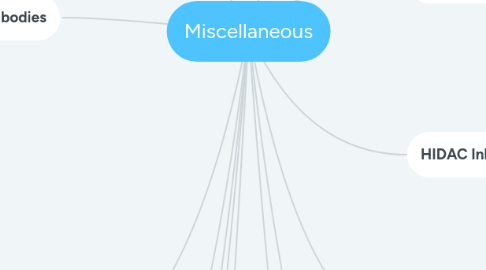
1. Biological Response and Modifiers and Immune Modulators
1.1. Interferon-alpha
1.1.1. AEs: flu-like, fever, fatigue
1.2. IL-2
2. Antibodies
2.1. As biological response modifiers, promote ADCC
2.1.1. Rituximab
2.1.1.1. AEs: infusion rxn, cardiac arrest, tumor lysis syndrome
2.1.2. Obinutuzumab
2.1.3. Alemtuzumab
2.1.4. Blinatumomab
2.2. Multiple myeloma and immune response modifier
2.2.1. Daratumumab
2.2.1.1. IgG1k mAB against CD38
2.2.2. Elotuzumab
2.2.2.1. Binds SLAM
2.3. Pediatric neuroblastoma
2.3.1. Dinutuximab
2.3.1.1. Chimeric mAB binds GD2
2.4. T-cell modulator
2.4.1. Ipilimumab
2.4.1.1. anti-CTLA4
2.4.1.2. AEs: autoimmune related rxns
2.4.2. Nivolumab
2.4.2.1. anti-PD-1
2.4.3. Pembrolizumab
2.4.3.1. anti-PD-1
2.4.4. Atezolizumab
2.4.4.1. Anti-PDL1 inhibitor
3. PARP Inhibition
3.1. Oliparib
3.1.1. Blocks SSBR in cells
3.1.2. Ovarian cancer
3.2. Rucaparib
3.2.1. Blocks SSBR in cells
3.2.2. Ovarian cancer
3.3. Niraparib
3.3.1. Ovarian, fallopian, peritoneal
3.4. Talazoparib
3.4.1. Breast
4. CDK Inhibitors
4.1. Palbociclib
4.1.1. block cell cycle progression
4.2. Abemaciclib
5. Extracellular: Antibodies at Growth Factor RTK inhibitors
5.1. Cetuximab
5.1.1. IgG1 type chimeric mAb against EGFR
5.1.2. AEs: infusion rxn, HTN
5.2. Panitumumab
5.2.1. IgG2 type fully human mAb against EGFR
5.3. Bevacizumab
5.3.1. Humanized mAb against VEGF-A
5.4. Necitumumab
5.4.1. mAb against EGFR
5.5. Margetuximab
5.5.1. mAb against HER2
5.5.2. AEs: infusion rn, HTN, delayed tox
5.6. Olaratumab
5.6.1. mAb that blocks PDGFRa
5.7. Ramucirumab
5.7.1. mAb that binds to VEGFR2
6. Growth Factor Receptor Inhibition
6.1. Aflibercept
6.1.1. Bind VEGF and PGF
6.1.2. AEs: GI, compromised wound healing
6.1.3. BBW: hemorrhage
6.2. Siltuximab
6.2.1. binds to IL-6
7. MAP Kinase Signaling
7.1. Serine/threonine kinase inhibitors
7.1.1. Vemurafenib
7.1.2. Dabrafenib
7.2. MEK/ERK Inhibitors
7.2.1. Trametinib
7.2.2. Cobimetinib
7.2.3. Binimetinib
7.2.4. Selumetinib
8. Differentiating Agents
8.1. Tretinoin
8.1.1. Differentiation of immature blood cells into functional cells
8.1.1.1. AEs: vitamin A tox, CNs tox
8.2. Arsenic trioxide
8.2.1. Induces differentiation of APL cells
8.2.1.1. AEs: fatigue, heart abnormalities
9. Proteasome Inhibitor
9.1. Cartilzomib
9.1.1. AEs: Anemia, neutropenia, dyspnea, diarrhea
9.2. Ixazomib
9.2.1. AEs: Thrombocytopenia, GI, peripheral neuropathy
9.3. Bortezomib
10. HIDAC Inhibitors
10.1. Panobinostat
10.1.1. remove acetyl groups from lysine
10.1.2. AEs: diarrhea, cardiac tox, myelosuppression
10.2. Belinostat
10.2.1. remove acetyl groups from lysine
10.3. Tazemetostat
10.3.1. inhibitor of EZH2 histone methyltransferase
11. BCL2 Inhibitor
11.1. Venetoclax
11.1.1. AEs: tumor lysis syndrome, neutropenia
12. Intracellular: TK Inhibitors (small molecules)
12.1. Geftinib
12.1.1. AEs: skin rash, diarrhea
12.2. Erlotinib
12.2.1. AEs: same as Getfttinib
12.3. Imatinib
12.3.1. Inhibits at BCr-Ab1 oncoprotein
12.3.2. AEs: N, V, delayed tox
12.4. Dasatinib
12.4.1. Inhibits VCr-Ab1, Src, c-kit, PDGFR-beta
12.5. Nilotinib
12.5.1. Same moa as Dasatinib
12.6. Bosutinib
12.7. Omacetaxine
12.8. Ponatinib
12.8.1. BB warning -- arterial occlusion
12.8.2. AEs: thromboembolism, HF, hepatox
13. GPCR Inhibitor
13.1. Vismodegib
13.1.1. activates Hedgehod signaling
13.2. Sonidegib
13.2.1. Inhibits Smo
